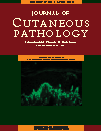Expression of α-methylacyl-CoA racemase (P504S) in sebaceous neoplasms
Abstract
Background:α-Methylacyl-CoA racemase (AMACR), also known as P504S, is a protein that plays an important role in mitochondrial and peroxisomal β-oxidation of branched-chain fatty acid and bile acid intermediates. AMACR has been established as a valuable diagnostic marker for prostate cancer and has recently been shown to be useful in the diagnosis of colorectal carcinoma. Despite the importance of lipid metabolism in sebum production by sebaceous glands of the skin, there are no studies evaluating the expression of AMACR in sebaceous neoplasms.
Methods: Five samples of normal sebaceous glands as well as five cases each of sebaceous hyperplasia (SH), sebaceous adenoma (SA), basal cell carcinoma (BCC) with sebaceous differentiation and extraocular sebaceous carcinoma (SC) were evaluated for immunohistochemical (IHC) expression of AMACR. Each case was reviewed by a single dermatopathologist and graded using a semi-objective grading schema.
Results: Normal sebaceous glands showed strong (4+) expression of AMACR. Among sebaceous neoplasms, SH showed the highest expression (4+), SA and BCC with sebaceous differentiation showed varied expression (2+ and 1+, respectively), and extraocular SC showed no expression of AMACR.
Conclusions: The expression of AMACR is increased in benign sebaceous glands and SH; with decreasing AMACR expression in tumors with less sebaceous differentiation (i.e. SA and SC). These findings provide insight into the potential pathogenesis of sebaceous neoplasms while assisting in the microscopic distinction of SA from SC.
Halsey MA, Calder KB, Mathew R, Schlauder S, Morgan MB. Expression of α-methylacyl-CoA racemase (P504S) in sebaceous neoplasms.




